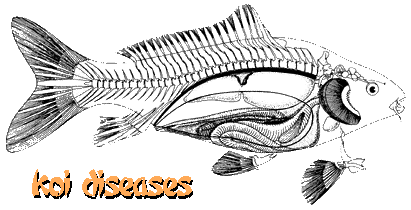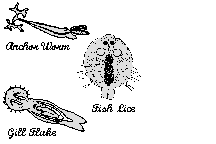

A Koi's health depends upon the environment provided by the human owner. Koi have a high resistance normally and succumb to disease usually only after exposure to stressful conditions that break down the normal immune system. A stressed fish becomes a sick fish. It has been said that:
Stress is the main factor man has the most control over. Many disease causing
organisms normally occur in the same environment as the fish. They usually only
become a problem when present in significant quantities and/or stress occurs.
Therefore, by controlling stress you can help maintain a healthy pond. Prevention
is easier than treating your pond for disease.
Some causes of stress are:
Disease Agents:
1. Bacterial
One of the principal causes of fish mortality is bacterial disease. Except for
"columaris" nearly all bacterial infections occur secondarily to some other
primary stress. Most are gram-negative organisms. Treatment: acriflavin,
nitrofurans, oxytetracycline, kanamycin, chloramphenicol, sulfanomides, salt, etc. as a dip, topical, injection, or in feed.
2. Viral
I know of no effective treatment except to remove nodular growths by scraping.
3. Fungal
A secondary infection at the site of some other fish injury. Also affects damaged
or disturbed fish eggs. Treatment: acriflavin, iodine, malachite green,
methylene blue, salt, formalin as a bath, topical, or in pond.
Most fish carry some parasites, but develop a degree of resistance that prevents
problems. On the other hand, parasites such as anchor worms and fish lice
usually are a problem whenever present. Young fish are more susceptible to
illness caused by parasites. Stress situations and/or seasonal climatic
variations may bring on infection. Some parasitic infections can be mistaken for
bacterial diseases or viral infections and some may cause tumors. Treatment:
Dylox, Masoten, Demilin, Formalin, Malachite Green, potassium permanganate or
salt in the whole pond or in a bath.
Treating fish diseases is sometimes a haphazard affair because we do not always
exactly know what the fish is suffering from. It is not easy to make a correct
diagnosis and then, from that "guess," choose a medication and dosage. Treatments
for Koi diseases are still relatively unsophisticated. There are no funds
available in the U.S. for the development of ornamental fish medicine.
Note: Dead fish decompose very rapidly and generally are of little diagnostic use
even if they have been frozen. It is better to have someone examine a live,
diseased fish. Fish cannot be examined over the telephone!
Methods of chemical treatment, (listed from most conservative to most drastic):
Whole pond treatment advantages include apparent ease of administration and a
desire to destroy all the harmful pathogens. The disadvantages are that
biological filtration may be severely affected and drugs used in the treatment
tend to be absorbed by organic debris in the pond. In addition, therapeutic drug
levels may not be reached as pond drug dosages are usually lower.
External swabbing with antibiotics and/or disinfectants can be surprisingly
effective. The disadvantage is that the fish is exposed to handling and
possibly anesthetics.
Medication should be attempted after water quality and stress conditions have
been improved. Partial water changes are very effective in improving water
quality and relieving stress.
Beware of the problem of disease organisms that may be resistant to a particular
drug. Maintain a current listing of drugs that are effective. Acriflavin, for
example, is frequently used for shipping and handling of fish, and has been
abused to the point that strains resistant to this drug are not uncommon.
Suggestions for a Koi first aid kit:
 4. Parasitic
4. Parasitic
* Herwig Nelson: Handbook of Drugs and Chemicals Used in the Treatment of Fish
Diseases. Springfield, Illinois. Charles C.Thomas, Publisher.
For more information: Dr. Erik Johnson's Web Page.